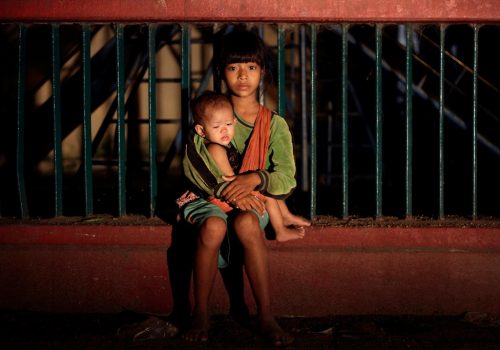Setting aside any desires for development and “modernity” with reference to other major Asian capitals, the Cambodian city of Siem Reap has nothing in common with these megacities. Mid-sized cities like Battambang have preserved their provincial character, which goes back to the times of the protectorate, and possess traces of colonial architecture.
This is also true of Siem Reap, if one can ignore the frantic construction of tourist facilities. Outside the few areas frequented by passing foreigners, the lighting after nightfall is rather scant, or even nonexistent. The same is true of Phnom Penh, the state capital. Although it houses over 2 million inhabitants, outside the main thoroughfares the city is plunged in utter darkness as soon as the sun sets, that is around eight o’clock in the evening. Once hailed as “the Paris of Indochina,” although it now glorifies buildings constructed without any urban planning, the city still preserves many of the aspects of its former life, down to the labyrinthine streets that resemble villages nestled within a large city. A million of small-engine two-wheelers crisscross the capital alone and flock in impressive clusters in front of the car queue at the red lights.
In 2010, Philon Sovann did an internship run by Antoine d’Agata as part of the Angkor Photo Festival in Siem Reap. But what should one photograph in a city entirely dedicated to commerce and tourism? How to escape the architecture and avoid the throngs of visitors trailing behind their guides? First of all, by avoiding daylight; by going out to meet those whom one never sees, who live and work in the shadows, in every meaning of the word. This radical decision, stemming from a simple observation, gave rise to a series that sets a new landmark in one of the most frequently tackled themes in photography over the past quarter century: the image of the city.
While he was trying to figure out how to portray the night, Philon Sovan discovered in Siem Reap that the headlight of his motorbike captured unsuspected street scenes in the dark. He knew right away that these “apparitions” were going to be his subject, and he decided to use his headlight to illuminate what he wanted to photograph. He sometimes jokingly compares himself to a hunter who traps his rabbit with a beam of light. Admittedly, his shots, taken with his bike resting on its kickstand and his camera on its tripod, following a precise light measurement to control the exposure, aren’t short on picturesque qualities.
In the City by Night, singular in terms of both form and content, has a natural place in the career of a photograph mad about light, enthusiastic about the documentary form, about testimony, about social questions which he seeks to address with non-conventional aesthetics. He quickly realized with his experience in the daily press that the rapid turnover of news coverage was too ephemeral and too superficial, and, unaware that this was common practice, began to develop “personal projects.” All his projects are based on an apprehension of light.
His work is also imbued with mystery in its exploration of the city that incorporates both documentary tendencies and fictional effects generated by lighting. The introduction of a focused beam of light evokes a cinematographic dimension, which lends a sense of unreal to the scenes it fixes, rather than freezing or revealing them.
We thus discover a whole invisible population in portraits marked by a context that lends them a symbolic value. This complex portrait gallery must be placed in the context of the recent developments in the representation of the city. The majority of recent approaches to the city, preoccupied with the issues of spatial organization, have tended to minimize, to the point of ignoring them altogether, those who inhabit these spaces. It goes to Philong Sovan’s credit that he was able to place people at the center of his project and inscribe them within the urban complexity at a key moment in the city’s history and development.
Staged and realistic, documentary and totally invented, Sovan’s photographs don’t aspire to any “truth.” They reflect questions faced today by a young Cambodian man with respect of his country’s cities and their rapid transformation, which compels him to question its meaning and attempt to preserve the traces of the passing life.
Christian Caujolle
Currently working as an independent curator, Christian Caujolle was formerly the director of photography at Libération,he founded the agency and gallery VU’. He also teaches at the École Nationale Supérieure Louis Lumière in Paris.
Sovan Philong, In the City by Night
April 26 to May 19, 2018
Galerie Lee
9, rue Visconti
75006 Paris
France
















